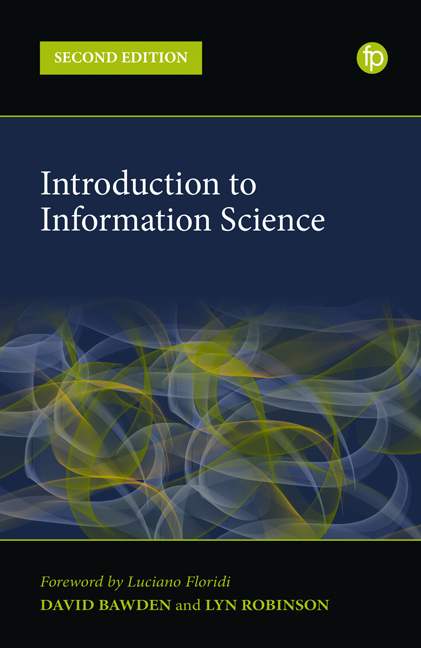Book contents
- Frontmatter
- Contents
- Figures
- Preface
- Foreword – Curators of Semantic Capital
- List of Acronyms
- 1 The Information Science Discipline
- 2 History of Information: the Story of Documents
- 3 Philosophies of Information
- 4 Paradigms, Turns and Theories in the Information Sciences
- 5 Information
- 6 Documents and Documentation
- 7 Domain Analysis
- 8 Information Organisation
- 9 Digital Technologies and Data Systems
- 10 Information Systems
- 11 Informetrics
- 12 Information Behaviour
- 13 Communicating Information: Changing Contexts
- 14 Information Management and Policy
- 15 Information Law and Ethics
- 16 Information Society
- 17 Digital (Onlife) Literacies
- 18 Research in the Information Sciences
- 19 The Future of the Information Sciences
- Additional Resources
- Index
11 - Informetrics
Published online by Cambridge University Press: 21 April 2022
- Frontmatter
- Contents
- Figures
- Preface
- Foreword – Curators of Semantic Capital
- List of Acronyms
- 1 The Information Science Discipline
- 2 History of Information: the Story of Documents
- 3 Philosophies of Information
- 4 Paradigms, Turns and Theories in the Information Sciences
- 5 Information
- 6 Documents and Documentation
- 7 Domain Analysis
- 8 Information Organisation
- 9 Digital Technologies and Data Systems
- 10 Information Systems
- 11 Informetrics
- 12 Information Behaviour
- 13 Communicating Information: Changing Contexts
- 14 Information Management and Policy
- 15 Information Law and Ethics
- 16 Information Society
- 17 Digital (Onlife) Literacies
- 18 Research in the Information Sciences
- 19 The Future of the Information Sciences
- Additional Resources
- Index
Summary
To measure is to know. If you cannot measure it, you cannot improve it.
Attributed, in various forms, to William Thomson, Lord KelvinIntroduction
This chapter is about measurement; specifically, measurement of the quantitative aspects of the creation, communication and use of information.
As Lord Kelvin reminds us (above), measurement is vital; but only if the right things are measured and the measurements are meaningful and up to date. In this chapter we will first examine the nature of informetrics and its components, before looking at how the subject has developed since its origins. We will consider the very basic question of how much information there is before looking, without extensive mathematics and with a focus on qualitative significance, at the main informetric laws – those of Lotka, Bradford and Zipf. Finally, we will look at how informetrics techniques may be applied in information research and practice.
Informetrics is the study of the quantitative aspects of information resources and of the communication of information. The term ‘informetrie’ was introduced by Otto Nacke (1979), a German documentalist and medical information specialist, and popularised as ‘informetrics’ by the British information scientist Bertie Brookes. Informetrics is usually taken to include several more specific subjects: bibliometrics, the study of quantitative aspects of published documentation; webometrics (also termed webliometrics or cybermetrics), the study of quantitative aspects of web resources; scientometrics, the quantitative study of the growth and change of academic disciplines, and altmetrics, assessing significance by measures not reliant on formal publication.
Ball (2021), Abrizah et al. (2014), Gingras (2016), Cronin and Sugimoto (2014), Sugimoto (2016), Bar-Ilan (2008; 2017), Hood and Wilson (2001), Wilson (1999) and Tague-Sutcliffe (1992) all give detailed accounts of the origins, meanings and interrelations of these terms and of others which have been used for this subject, and review the subject in general; see also Bawden and Robinson (2016) for an account of some numbers which are significant for the information sciences.
The major bibliometric laws – actually approximate statistical relations, rather than true laws describing patterns and regularities in quantitative aspects of documentation – are those of Lotka, Bradford and Zipf. They describe general patterns, typically rank frequency distributions, observed in social situations including in the world of bibliography and documentation.
- Type
- Chapter
- Information
- Introduction to Information Science , pp. 207 - 226Publisher: FacetPrint publication year: 2022



